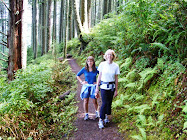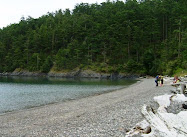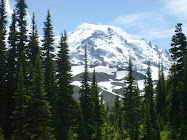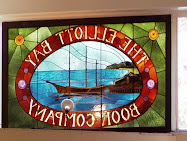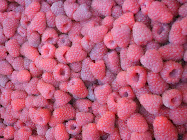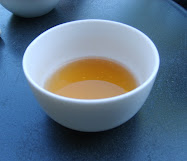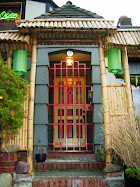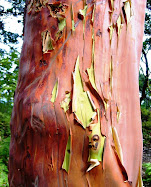
Are you willing to make a few tradeoffs for an affordable, relaxing
San Juan Islands getaway?
Like the idea of soaking in hot mineral baths above a picturesque cove, dining on garden-fresh gourmet fare, and kayaking past plump purple
starfish clinging to rock ledges?
Don’t mind temperamental plumbing, not-so-soundproof lodging, and communal kitchens and showers?
Doe Bay Resort on Orcas Island offers all of those things and more. What draws me back is the lovely, accessible waterfront setting with expansive views across
Rosario Strait, and the friendly, tolerant ambience.

I just spent a few nights at Doe Bay and arrived home refreshed from all that clean island air. Yes, it was another drippy, cloudy Memorial Day weekend here in the Upper Left Hand corner. But if it bothered me too much, I’d up and leave.
I’m still here.
Getting ThereOriginally we planned to car camp at Doe Bay, but when we’re on the
ferry to Orcas, the relentless rain doesn’t bode well for a comfy few days. “How about we call and see if there’s still an indoor room available,” I suggest.
Lucky us, somebody just cancelled their reservation on the top floor of the Ananda duplex. (Place names around Doe Bay Resort, such as Prana,
Ganesh, and
Ananda, are leftovers from its granola-hippie past, which isn’t completely gone but just evolved. Regular yoga classes, clothing-optional hot tubs, and communal gardening are still happening here.)
After a good lunch at
Mia’s in Eastsound (the island-grown greens salad is gorgeous), we drive southeast down island and pull into Doe Bay mid-afternoon.

If you’re driving straight to Doe Bay from the Orcas Village ferry landing, it’s a meandering 30-minute drive along mostly tree-lined roads. Watch out for bicyclists lugging panniers along the narrow, shoulderless roads. Many are headed to Doe Bay, which offers a discount to those arriving by bicycle.
ArrivingDoe Bay’s setting reminds me of a tiny seaside village, with small buildings scattered around the gently sloping site, fringed by verdant forest. A group of families with small kids is playing Frisbee on the lawn when we check in at the historic Doe Bay Store/Office.
.jpg)
Our building, tucked in the woods above the central lawn/open space, wouldn’t win any architectural awards. It looks like an off-kilter tree house without the tree. But it’s relatively comfortable and cozy, sort of like covered, heated camping. Spiraling bird songs (mostly
varied thrush) echo through the trees, laying a lovely soundtrack.
“Otters!” says a woman as I walk down to the waterfront to take in the view.
.jpg)
About five brown
river otters, their slick wet fur shining in a brief glimpse of sun, slither around the exposed, barnacle-encrusted rocks below, dipping in and out of the water in quick bursts. We’re close enough to see them prying food from the rocks with their front paws and stuff it into their mouths in quick gulps. The low tide, courtesy of a full moon, provides them a feast of mussels and other sea grub.
DiningSince I was last here, the food at the
Doe Bay Café has improved dramatically. Although the interior is still rustic and the floors in the old building slant a bit, the seasonal food is wonderful.
“We make the parpadelle pasta here with duck eggs from the island,” says our casual, friendly young waiter. I’m sold. The savory and incredibly tasty dish is spiked with wild black morel mushrooms, grilled asparagus, baby pear tomatoes, Swiss chard, and topped with an extravagant green crown of pea vines from the onsite organic garden. With great restraint, I leave a few bites of the perfectly cooked al dente pasta on my plate because, well, I really
don’t need the calories.

Rich’s hazelnut-crusted scallops with greens, avocado, and grapefruit disappear completely, quickly. We’re enjoying the sweet, soulful harmonies of
Homesick Elephant, a young neo-folk duo up from L.A., so we
have to order strawberry-rhubarb shortcake to prolong our stay.

Of course there’s that communal kitchen. When I’m up early heating water for tea with my muffin, a beautiful Asian-American woman offers me some of her reheated pot roast. (Remember I said
friendly?). I wonder how she manages to look so elegant before 8 a.m. in rubber boots and an old leather jacket
KayakingWhen the tide is low, kayaking off Doe Bay is like a waterborne trip to an aquarium. Close to the exposed rock faces that surround much of the San Juan Islands, we glide past clumps of orange and purple starfish (sea stars) splayed across the rocks as if frozen mid-dance. Below us under the clear water surface, translucent brown seaweed sways like dancers at a Grateful Dead concert. Above us bald eagles perched in treetops call out their plaintive, squeaky cries, and neon-red beaked
oyster catchers peep-peep-peep.

We brought our own sea kayaks, but you can sign up for guided trips from the beach at Doe Bay led by
Shearwater Kayak outfitters. Be careful of the strong currents in
Rosario Strait, and don’t stray too far offshore during maximum flood or ebb tides if you’re a newbie kayaker. “You could get swept all the way up to B.C. in the strong currents,” warns the guy at the front desk when we check in and mention kayaking solo.

 Soaking
SoakingTo get immersed (literally and figuratively) in the real spirit of Doe Bay, you really should soak in the hot tubs, which are set on a large covered deck overlooking a tidal cove. I reach the tiled tubs by walking down a gravel path through lush green woods and across a little wooden bridge over a rushing stream.
Although a few people have stripped to their birthday suits, I modestly strip to my bathing suit and ease first into the “mama bear” (medium temperature) of the three tubs. Everyone is mellow and friendly (yes,
that word again) and we figure out we’re all from the Ballard area of Seattle.
After a few quick dips in the cool and hottest tubs, I loll a while in the medium tub until a large, talkative group descends. (For a quiet soak, go in the morning.) So I dry off, wander up to one of the wooden Adironack chairs by the water, and settle in with my book.

Now
this is relaxing.
When You GoHere’s
a map showing Doe Bay’s location on Orcas Island.

I didn’t have any trouble getting a campsite ($35/night) just a couple weeks before Memorial Day, but that changes during the summer and early fall. Our room was $85/night. Bring your own flip flops if you’re using the communal showers, and a tolerant attitude towards the fussy toilets.
.jpg) As a kid, I loved the sweet English peas from our garden, thick Chinook salmon steaks that my father brought home from deep-sea fishing off Depoe Bay on the Oregon coast, strawberries we U-picked from berry fields scattered around east Multnomah County, lots of dill to accent flavors, and plump Bing cherries.
As a kid, I loved the sweet English peas from our garden, thick Chinook salmon steaks that my father brought home from deep-sea fishing off Depoe Bay on the Oregon coast, strawberries we U-picked from berry fields scattered around east Multnomah County, lots of dill to accent flavors, and plump Bing cherries.

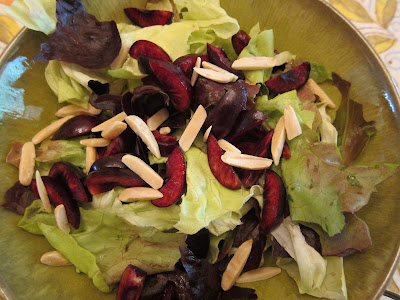






.jpg)








.jpg)
.jpg)














